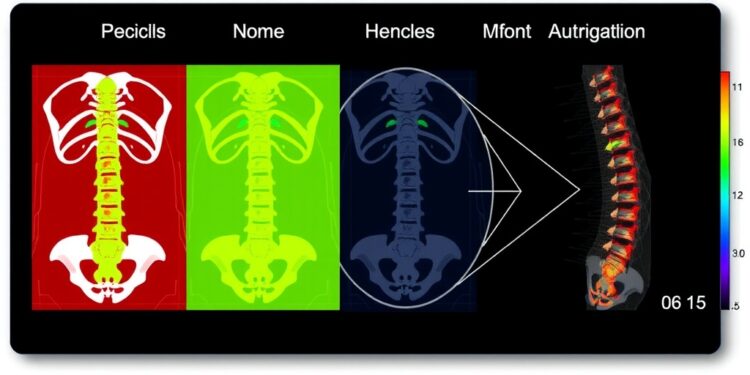In a groundbreaking study published in BioMedical Engineering OnLine, researchers have developed a sophisticated deep learning radiomics model that merges clinical insights with advanced imaging techniques, specifically targeting the prediction of high-risk cage subsidence (CS) following lumbar fusion surgery. This innovative approach promises to reshape how clinicians assess and manage patients undergoing spinal surgeries, potentially reducing complications and the necessity for revision surgeries.
Cage subsidence after lumbar fusion remains a significant concern for healthcare providers, often leading to severe postoperative complications and increased patient morbidity. Traditionally, the risk of CS has been predicted using subjective clinical assessments or basic imaging interpretation, which can be imprecise and vary significantly from one clinician to another. Recognizing the limitations of existing methodologies, the team of researchers embarked on a quest to harness the power of deep learning and radiomics to create a predictive model that could enhance clinical decision-making.
The study encompassed a comprehensive analysis of preoperative computed tomography (CT) and magnetic resonance imaging (MRI) data, collected from an extensive cohort of 305 patients across three separate medical centers. This large dataset provides a robust foundation for training the deep learning model, ensuring that the findings are generalizable and relevant across different clinical settings. By employing a 3D vision transformation methodology, the researchers effectively processed the imaging data, allowing for a nuanced analysis of the radiomic features present within the images.
To ensure the reliability of the model, the dataset was meticulously divided into three distinct groups: a training cohort of 214 patients, a validation cohort of 61 patients, and a testing cohort of 30 patients. The stratification into these groups facilitates a stringent evaluation of the model’s predictive proficiency, enabling the researchers to refine the algorithm iteratively based on the performance across each group. Essential to this process was the use of LASSO regression for feature selection, a statistical method that enhances the model’s accuracy by identifying the most relevant variables while minimizing the risk of overfitting.
The authors of this study observed that the model’s predictive capabilities were significantly bolstered by the inclusion of both traditional and deep learning radiomic features. Specifically, the final model integrated 11 traditional radiomic features, five deep learning-derived features, alongside a single clinical variable. This comprehensive approach allows the model to capitalize on both quantitative imaging data and qualitative clinical assessments, fostering a more dynamic and multifaceted predictive landscape.
The results of the study are indeed impressive, with the combined model achieving area under the curve (AUC) values of 0.941, 0.832, and 0.935 for the training, validation, and test groups, respectively. These metrics indicate a highly robust model that can accurately identify patients at risk of CS with remarkable precision. In a remarkable testament to its efficacy, the model surpassed the predictive capabilities of two seasoned surgeons, underscoring the potential of machine learning algorithms in augmenting clinical judgment.
The implications of this research extend beyond mere statistical accomplishments. The ability to identify high-risk patients can significantly alter surgical practices, guiding surgeons towards more informed decision-making processes. By providing healthcare professionals with a dynamic tool for risk assessment, there is a substantial opportunity to enhance patient outcomes and minimize the incidence of adverse events following lumbar fusion procedures.
Moreover, the insights gleaned from this research have broader ramifications for the field of spinal surgery. As surgical techniques advance and the complexity of cases continues to increase, the integration of predictive modeling into clinical workflows will likely become paramount. The model developed in this study represents a critical step towards the realization of personalized medicine in orthopedics, where treatment protocols can be tailored to the unique needs of individual patients based on predictive analytics.
In light of these findings, it is evident that the future of spinal surgery will be influenced heavily by technological innovations. As advancements in deep learning and radiomics progress, we can anticipate further refinements in model accuracy and applicability. Additionally, the potential for real-time data integration during surgical planning presents an exciting frontier that could revolutionize postoperative care and long-term patient monitoring.
As researchers continue to validate and refine this model, opportunities for collaboration across various disciplines, including engineering, data science, and clinical practice, will be vital. Interdisciplinary approaches will be critical in overcoming existing limitations and fostering an environment conducive to the continuous evolution of predictive modeling in healthcare. The insights gained from such collaborative efforts can propel further research and promote the adoption of advanced analytics in clinical routines.
With the momentum generated by this study, the healthcare community is urged to explore the integration of such predictive tools within routine clinical assessments. Emphasizing the importance of data-driven approaches in treating complex conditions will not only enhance individual patient care but may also lead to significant savings in healthcare costs associated with revision surgeries and prolonged recovery times.
In conclusion, the development of a deep learning radiomics model that combines clinical data and advanced imaging techniques represents a significant leap forward in the quest for improved patient outcomes in spinal surgery. This pioneering research lays the groundwork for future studies aimed at refining these predictive techniques, ultimately striving for a future where personalized treatment strategies become the norm rather than the exception.
Subject of Research: Predictive modeling of cage subsidence following lumbar fusion surgery
Article Title: Development of a deep learning radiomics model combining lumbar CT, multi-sequence MRI, and clinical data to predict high-risk cage subsidence after lumbar fusion: a retrospective multicenter study
News Publication Date: 2025
Web References: N/A
References: N/A
Image Credits: N/A
Keywords: deep learning, radiomics, lumbar fusion, cage subsidence, predictive modeling, clinical data, imaging techniques, healthcare innovation.




